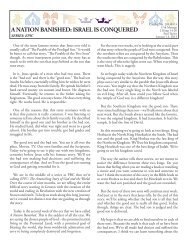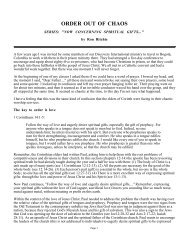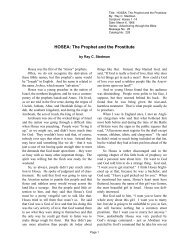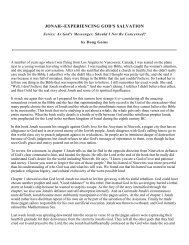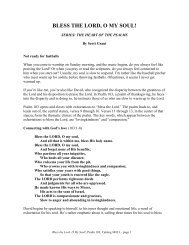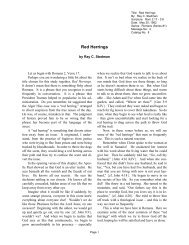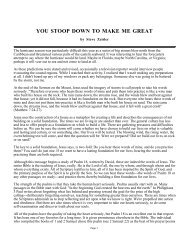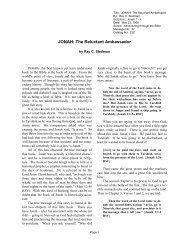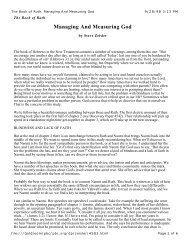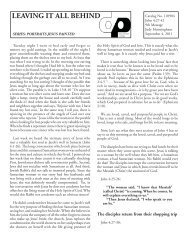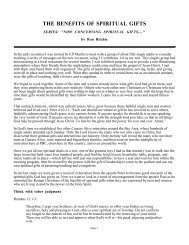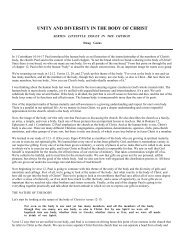Basics of Bible Interpretation - RayStedman.org
Basics of Bible Interpretation - RayStedman.org
Basics of Bible Interpretation - RayStedman.org
Create successful ePaper yourself
Turn your PDF publications into a flip-book with our unique Google optimized e-Paper software.
a) Euphemism—the substitution <strong>of</strong> an in<strong>of</strong>fensive or mild expression for one that might <strong>of</strong>fend<br />
or suggest something unpleasant.<br />
Isaiah 57:8—“You loved their bed. Their ‘hand’ you gazed at” (for illicit sexual desire).<br />
b) Metonymy—the use <strong>of</strong> a concrete term for another more abstract idea.<br />
Isaiah 22:22—“Then I will set the key (way to gain access) <strong>of</strong> David on his shoulder…” (as a<br />
burden, or heavy responsibility).<br />
c) Synechdoche—a use <strong>of</strong> the whole for a part or a part for the whole.<br />
Isaiah 53:10—“If he would render up his soul (himself) as a guilt <strong>of</strong>fering”<br />
d) Merism—a form <strong>of</strong> synechdoche where a totality is expressed by two opposites.<br />
Genesis 1:1—“In the beginning God created the heavens and the earth…” (i.e., the universe).<br />
e) Personification—the representation <strong>of</strong> inanimate objects or abstract objects as endowed<br />
with personal attributes.<br />
Isaiah 35:1—“The wilderness and the desert shall be glad…”<br />
f) Apostrophe—a turning away from one’s audience to address directly a person or thing, or<br />
an abstract idea or imaginary object (frequent in prophetic books).<br />
g) Hyperbole—an exaggeration used for emphasis. Isaiah 34:1-17 (Description <strong>of</strong> the<br />
destruction <strong>of</strong> nations).<br />
h) Irony—the intended implication is opposite the literal meaning <strong>of</strong> the words.<br />
Isaiah 41:23 (Addressed to idols)—“Indeed, do good or evil that we may anxiously look about us<br />
and fear.”<br />
j) Simile—one thing, action or relationship is explicitly compared with something else (“as”<br />
or “like”).<br />
k) Metaphor—a word or phrase used in place <strong>of</strong> another to suggest a likeness or analogy.<br />
Isaiah 1:10—“Hear the word <strong>of</strong> the Lord, you rulers <strong>of</strong> Sodom (Jerusalem).”<br />
l) Hendiadys—a stylistic device in which two coordinate terms are joined by “and” to convey<br />
a single concept.<br />
Genesis 3:16—“I will greatly multiply your pain and childbirth” (i.e. “painful childbirth”).<br />
m) Anthropomorphism—the representation <strong>of</strong> God in the form <strong>of</strong>, or with the attributes <strong>of</strong>, a<br />
man.<br />
Isaiah 7:18—“And it shall come about that the Lord will whistle for the fly which is at the<br />
sources <strong>of</strong> the rivers <strong>of</strong> Egypt.”<br />
n) Anthropopathism—the ascription to God <strong>of</strong> the emotions and passions <strong>of</strong> man.<br />
Psalm 2:4—“He who sits in the heavens will laugh.”<br />
o) Zoomorphism—the representation <strong>of</strong> God in the form <strong>of</strong>, or with the attributes <strong>of</strong>, the lower<br />
animals.<br />
Psalm 63:7—“In the shadow <strong>of</strong> thy wings I sing for joy.”<br />
There are other less frequently used symbols in the Old Testament. E. W. Bullinger’s Figures<br />
<strong>of</strong> Speech Used in the <strong>Bible</strong> (Baker Book House) will give you a more complete listing. Those<br />
listed here, however, are the figures <strong>of</strong> speech you will encounter most <strong>of</strong>ten in the Old<br />
Testament and, once understood, will give you a greater appreciation for the Hebrew mind and<br />
the image-producing faculty <strong>of</strong> the Hebrew language. Again, you need to bear in mind that the<br />
purpose <strong>of</strong> the author is to produce a vivid mental picture rather than convey a merely abstract<br />
concept. Keeping that purpose in mind will prevent you from going beyond the intent <strong>of</strong> the<br />
author.<br />
And now, a word about words and how to define them. Unfortunately, there are fewer tools<br />
in Hebrew for the non-specialist than there are in Greek, but there are some available and you<br />
should learn how to use them. They can help you get beyond the English translations to the<br />
meaning <strong>of</strong> the Hebrew texts underlying them. They are:<br />
<strong>Basics</strong> Of <strong>Bible</strong> <strong>Interpretation</strong> – page 112



